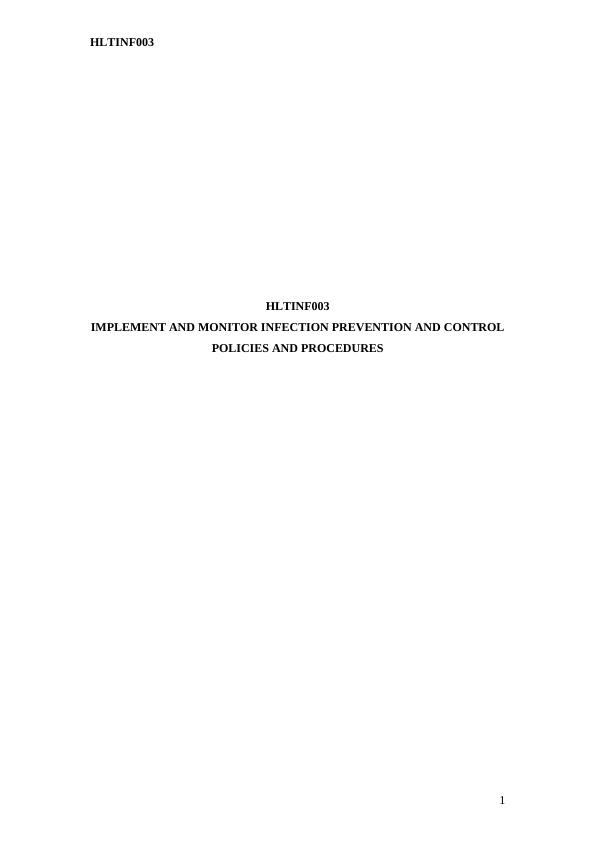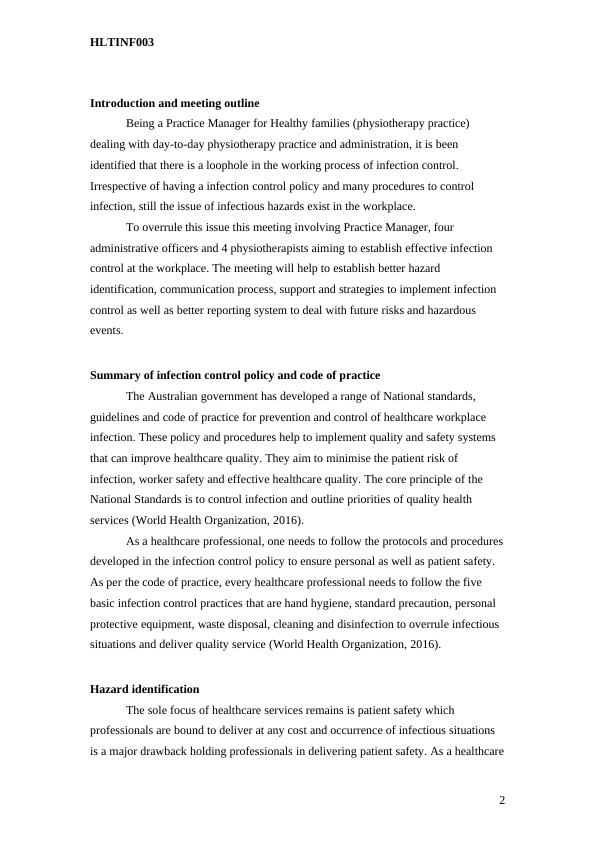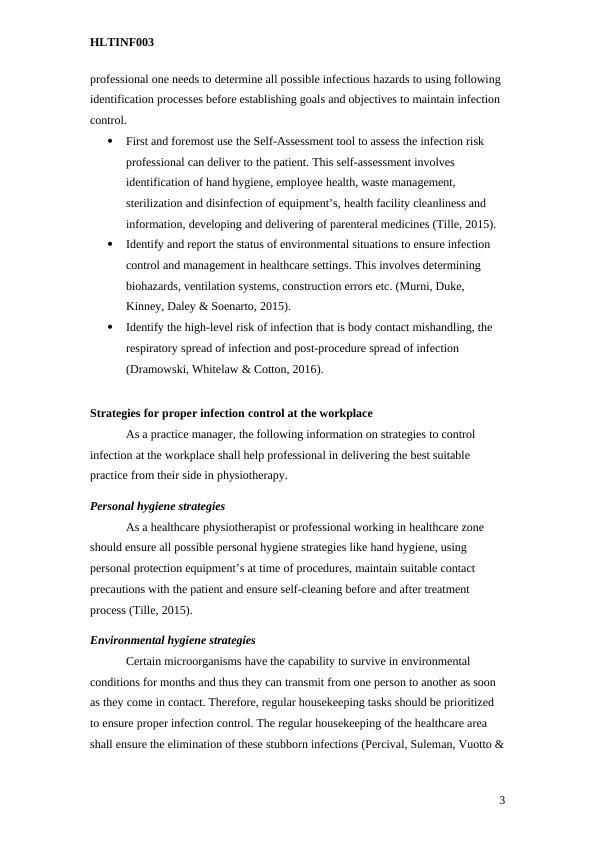Implement and Monitor Infection Prevention and Control Policies and Procedures
Added on 2023-01-20
8 Pages1753 Words22 Views
HLTINF003
HLTINF003
IMPLEMENT AND MONITOR INFECTION PREVENTION AND CONTROL
POLICIES AND PROCEDURES
1
HLTINF003
IMPLEMENT AND MONITOR INFECTION PREVENTION AND CONTROL
POLICIES AND PROCEDURES
1

HLTINF003
Introduction and meeting outline
Being a Practice Manager for Healthy families (physiotherapy practice)
dealing with day-to-day physiotherapy practice and administration, it is been
identified that there is a loophole in the working process of infection control.
Irrespective of having a infection control policy and many procedures to control
infection, still the issue of infectious hazards exist in the workplace.
To overrule this issue this meeting involving Practice Manager, four
administrative officers and 4 physiotherapists aiming to establish effective infection
control at the workplace. The meeting will help to establish better hazard
identification, communication process, support and strategies to implement infection
control as well as better reporting system to deal with future risks and hazardous
events.
Summary of infection control policy and code of practice
The Australian government has developed a range of National standards,
guidelines and code of practice for prevention and control of healthcare workplace
infection. These policy and procedures help to implement quality and safety systems
that can improve healthcare quality. They aim to minimise the patient risk of
infection, worker safety and effective healthcare quality. The core principle of the
National Standards is to control infection and outline priorities of quality health
services (World Health Organization, 2016).
As a healthcare professional, one needs to follow the protocols and procedures
developed in the infection control policy to ensure personal as well as patient safety.
As per the code of practice, every healthcare professional needs to follow the five
basic infection control practices that are hand hygiene, standard precaution, personal
protective equipment, waste disposal, cleaning and disinfection to overrule infectious
situations and deliver quality service (World Health Organization, 2016).
Hazard identification
The sole focus of healthcare services remains is patient safety which
professionals are bound to deliver at any cost and occurrence of infectious situations
is a major drawback holding professionals in delivering patient safety. As a healthcare
2
Introduction and meeting outline
Being a Practice Manager for Healthy families (physiotherapy practice)
dealing with day-to-day physiotherapy practice and administration, it is been
identified that there is a loophole in the working process of infection control.
Irrespective of having a infection control policy and many procedures to control
infection, still the issue of infectious hazards exist in the workplace.
To overrule this issue this meeting involving Practice Manager, four
administrative officers and 4 physiotherapists aiming to establish effective infection
control at the workplace. The meeting will help to establish better hazard
identification, communication process, support and strategies to implement infection
control as well as better reporting system to deal with future risks and hazardous
events.
Summary of infection control policy and code of practice
The Australian government has developed a range of National standards,
guidelines and code of practice for prevention and control of healthcare workplace
infection. These policy and procedures help to implement quality and safety systems
that can improve healthcare quality. They aim to minimise the patient risk of
infection, worker safety and effective healthcare quality. The core principle of the
National Standards is to control infection and outline priorities of quality health
services (World Health Organization, 2016).
As a healthcare professional, one needs to follow the protocols and procedures
developed in the infection control policy to ensure personal as well as patient safety.
As per the code of practice, every healthcare professional needs to follow the five
basic infection control practices that are hand hygiene, standard precaution, personal
protective equipment, waste disposal, cleaning and disinfection to overrule infectious
situations and deliver quality service (World Health Organization, 2016).
Hazard identification
The sole focus of healthcare services remains is patient safety which
professionals are bound to deliver at any cost and occurrence of infectious situations
is a major drawback holding professionals in delivering patient safety. As a healthcare
2

HLTINF003
professional one needs to determine all possible infectious hazards to using following
identification processes before establishing goals and objectives to maintain infection
control.
First and foremost use the Self-Assessment tool to assess the infection risk
professional can deliver to the patient. This self-assessment involves
identification of hand hygiene, employee health, waste management,
sterilization and disinfection of equipment’s, health facility cleanliness and
information, developing and delivering of parenteral medicines (Tille, 2015).
Identify and report the status of environmental situations to ensure infection
control and management in healthcare settings. This involves determining
biohazards, ventilation systems, construction errors etc. (Murni, Duke,
Kinney, Daley & Soenarto, 2015).
Identify the high-level risk of infection that is body contact mishandling, the
respiratory spread of infection and post-procedure spread of infection
(Dramowski, Whitelaw & Cotton, 2016).
Strategies for proper infection control at the workplace
As a practice manager, the following information on strategies to control
infection at the workplace shall help professional in delivering the best suitable
practice from their side in physiotherapy.
Personal hygiene strategies
As a healthcare physiotherapist or professional working in healthcare zone
should ensure all possible personal hygiene strategies like hand hygiene, using
personal protection equipment’s at time of procedures, maintain suitable contact
precautions with the patient and ensure self-cleaning before and after treatment
process (Tille, 2015).
Environmental hygiene strategies
Certain microorganisms have the capability to survive in environmental
conditions for months and thus they can transmit from one person to another as soon
as they come in contact. Therefore, regular housekeeping tasks should be prioritized
to ensure proper infection control. The regular housekeeping of the healthcare area
shall ensure the elimination of these stubborn infections (Percival, Suleman, Vuotto &
3
professional one needs to determine all possible infectious hazards to using following
identification processes before establishing goals and objectives to maintain infection
control.
First and foremost use the Self-Assessment tool to assess the infection risk
professional can deliver to the patient. This self-assessment involves
identification of hand hygiene, employee health, waste management,
sterilization and disinfection of equipment’s, health facility cleanliness and
information, developing and delivering of parenteral medicines (Tille, 2015).
Identify and report the status of environmental situations to ensure infection
control and management in healthcare settings. This involves determining
biohazards, ventilation systems, construction errors etc. (Murni, Duke,
Kinney, Daley & Soenarto, 2015).
Identify the high-level risk of infection that is body contact mishandling, the
respiratory spread of infection and post-procedure spread of infection
(Dramowski, Whitelaw & Cotton, 2016).
Strategies for proper infection control at the workplace
As a practice manager, the following information on strategies to control
infection at the workplace shall help professional in delivering the best suitable
practice from their side in physiotherapy.
Personal hygiene strategies
As a healthcare physiotherapist or professional working in healthcare zone
should ensure all possible personal hygiene strategies like hand hygiene, using
personal protection equipment’s at time of procedures, maintain suitable contact
precautions with the patient and ensure self-cleaning before and after treatment
process (Tille, 2015).
Environmental hygiene strategies
Certain microorganisms have the capability to survive in environmental
conditions for months and thus they can transmit from one person to another as soon
as they come in contact. Therefore, regular housekeeping tasks should be prioritized
to ensure proper infection control. The regular housekeeping of the healthcare area
shall ensure the elimination of these stubborn infections (Percival, Suleman, Vuotto &
3

End of preview
Want to access all the pages? Upload your documents or become a member.
Related Documents
HLTIN403C Implement and Monitor Infection Control Policylg...
|7
|2451
|128
NATIONAL SAFETY & QUALITY HEALTH SERVICElg...
|10
|2635
|34
Infection Control Practices in Dental Settings - PDFlg...
|17
|3470
|64
Infection Prevention Control PDFlg...
|6
|777
|120
Health Support Worker Assignment 2022lg...
|20
|4014
|11
Health Safety in Care Settings: Practical Interventions to Reduce Risks to Staff and Service Userslg...
|13
|723
|224
